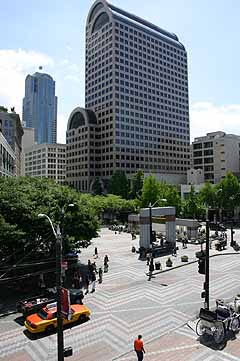
DJC.COM
June 29, 2006
Need a tenant rep for office leases?
Flinn Ferguson

Photo by Benjamin Minnick Outside of Seattle's Century Square building, there is little contiguous Class A office space in the city. |
Growing corporations throughout the region are facing some difficult decisions, specifically concerning the need for additional downtown office space. They’re weighing the benefits of either absorbing space in current office buildings or waiting on new developments to come online.
But with a local economy that’s seemingly getting more robust by the week, competition for existing Class A urban office space is rapidly increasing. The latest reports show that vacancies in the Seattle and Bellevue downtown cores have fallen significantly over the past couple of months.
Most industry professionals anticipate that trend to continue for a while, especially given the latest lease deals forged by Microsoft at Lincoln Square in Bellevue and Safeco at 1001 Fourth Avenue Plaza and the Second and Seneca Building, both in downtown Seattle. These deals, which combine for an 800,000-plus square-foot absorption, have dramatically changed how the local office market is being perceived by brokers, corporations and others.
Complicating matters is the fact that very little contiguous, centrally located space is available for lease in either urban area, aside from some limited amounts in Seattle’s Century Square building and a few unoccupied floors on the Eastside. And, given the inherent lag between the early stages of development and a building actually being ready for occupancy, there likely won’t be any significant inventory in the region for several months, if not a year or more.
That’s obviously good news for area real estate owners and developers, who are now rushing their projects to market in order to increase their chances of capturing a majority of the growing demand for space. Several exciting projects are under construction, while many other developers are working to secure land and permitting. These include Touchstone’s West 8th project, Vulcan’s 2201 Westlake, Schnitzer Northwest’s 818 Stewart building, and office projects being considered by Sabey Corp., Martin Selig Real Estate and others.
The crunch in supply of desirable downtown space has been brought about by, among other factors, a faster-than-anticipated correction in the Puget Sound-area economy. Certainly there’s been some recent anticipation within the corporate community for an economic rebound after several years of declining growth. But very few believed it would happen this soon, and almost no one could have predicted the bounce-back would carry such positive momentum.
This rapid economic recovery -- combined with the upward pressure on costs being applied by developers seeking land for their luxury condominium towers -- has increased the likelihood of regional Class A lease rates climbing significantly, and soon, for fully serviced properties. The newest office projects to come to market will set the mark, since their developers will require a minimum asking price to justify their projects.
Soon after, the owners of the best remaining Class A space in Seattle and Bellevue will follow, raising their lease rates to or near the asking price of these new developments. In fact, the process has already begun, with Equity Office Properties recently raising its rates by a dollar a square foot, across the board, and predicting as much as a 10 percent jump in region-wide lease rates by year’s end.
Given this scenario, companies these days are looking more and more to area brokerage houses, especially tenant-representation firms, for guidance in their decision making for physical expansions. Savvy brokers are helping these businesses to strategize their increased absorptions and make sure they negotiate a lease that best fits their budget and addresses their short- and long-term office needs.
Some of the most critical elements for corporations to consider in today’s burgeoning commercial real estate market include:
1. Retain a space planner to identify ways to reduce the total amount of space required for the business. Some methods include discarding old files, equipment and furniture, or sending them to temporary storage. Companies might also consider better using conference rooms and other building common areas.
2. Plan diligently in advance of negotiating the actual deal. The more time the corporation affords itself before signing the lease, the better chance it’ll have in negotiating a desirable package for the new space.
3. Be either the first or last tenant to secure a lease at a newly developed office building. In general, it’s the anchor tenants or the ones that take the last remaining space that get the best negotiated deals -- the first provide security to the owner while the last come at a time when there are more Class A space options in the marketplace.
4. Be realistic in expectations for what the market will bear in terms of space and the cost of that property. Commercial real estate is a fluid business, and asking prices are affected greatly by numerous factors, such as tenant credit ratings, the length of the lease, the amount of space being absorbed and the level of vacancy in various buildings.
5. Consider ownership of a building or creating a partnership with the developer. Some developers will exchange tenancy for immediate equity in the building or future profit sharing, which can protect a business against future rate increases through its equity participation.
Parker Ferguson is a principal at Flinn Ferguson, a Seattle corporate real estate firm focused on tenant representation.
Other Stories:
- Saving historic buildings with tax credits
- Urban core too pricey? Try the U District
- Home buyers find downtown Tacoma less taxing
- Are we ready for Seattle’s pivotal moment in history?
- Eastside bids adieu to its bedroom community image
- Will small businesses buy into condo offices?
- Smooth the development process by building trust
- Design quality is key in urban development
Copyright ©2009 Seattle Daily Journal and DJC.COM.
Comments? Questions? Contact us.